easy sourdough focaccia
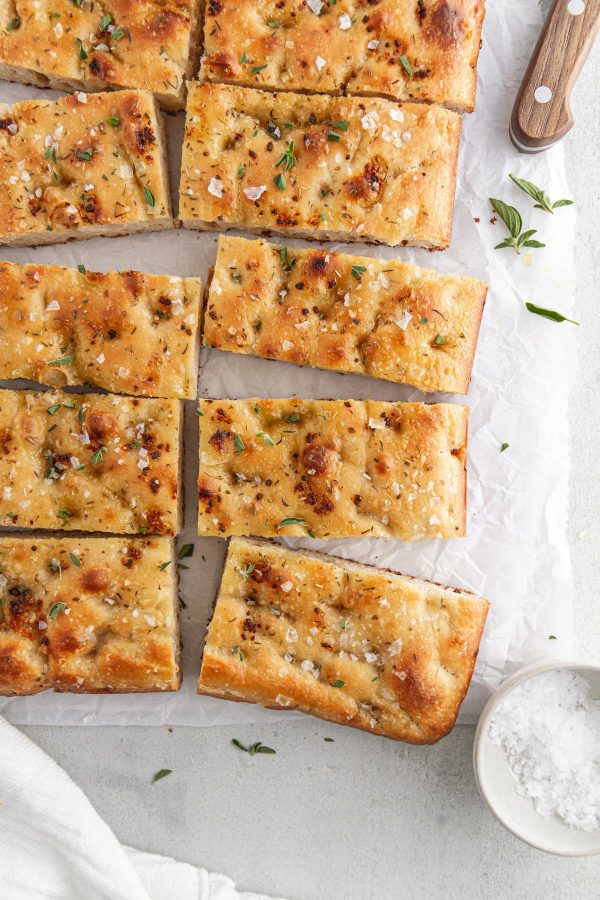
Looking for a fun and therapeutic baking project, or another way to use your sourdough starter besides making loaves of bread? Give this easy sourdough focaccia a try! This slow-and-steady (yet very easy-to-follow) recipe will guide you through the process of making your own crisp-on-the-outside, soft-on-the-inside and totally all-around delicious sourdough focaccia bread made from scratch. This is the final recipe in a month-long series I’m working on featuring recipes that use leftover sourdough starter. For a refresher on all things sourdough, head to this post!
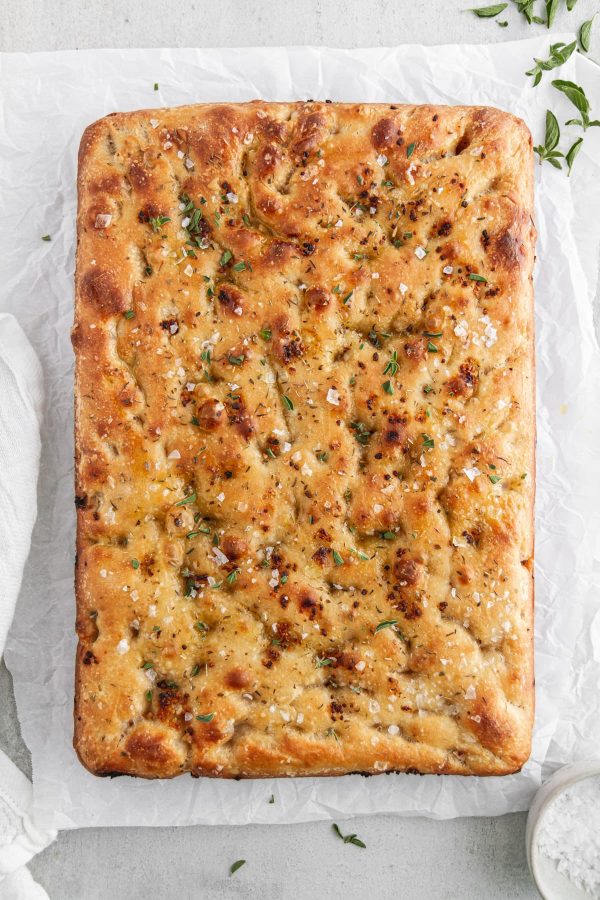
Say Hello to Sourdough Focaccia.
Hi. Hello. How are you doing? Here in Minnesota, we’re one week into a statewide “stay at home” order, which means almost everything is closed except for grocery stores, banks and a few other essential services. My kids have been home from school for almost three weeks, and I’ve been working my full-time job from home, as well (Elliott still goes into work because he is in healthcare). To say we are going a little stir-crazy is the understatement of the century, BUT — we are healthy, and safe, and I really can’t ask for anything more right now.
I hope that, wherever you are, you can say the same. I know it’s tough these days — I hesitated to even post this recipe because it’s a struggle to find inspiration lately. But I keep seeing everything you’re baking on social media, leaving comments here about your bread babies and how you’re finally making a sourdough starter for the first time, and I just can’t help but be proud of and encouraged by all the baking going on in this community and around the world. We are all in this together (HSM pun maybe intended). And so, let’s bake more bread together, too.
What is sourdough focaccia? It’s a little more complicated than focaccia that uses leftover sourdough starter, but it’s less time-consuming than a loaf of sourdough bread — meaning it really hits that sweet spot for intermediate bakers. If you’re not familiar with focaccia in general, it’s a flat, oven-baked Italian bread that’s flavored with olive oil and sometimes toppings (like garlic and herbs) and it’s often served as a table bread or sandwich bread. It’s crisp on the outside and incredibly soft and fluffy on the inside. And when you combine focaccia with sourdough, the results are like focaccia on steroids — extra-fluffy, extra-flavorful, extra-good.
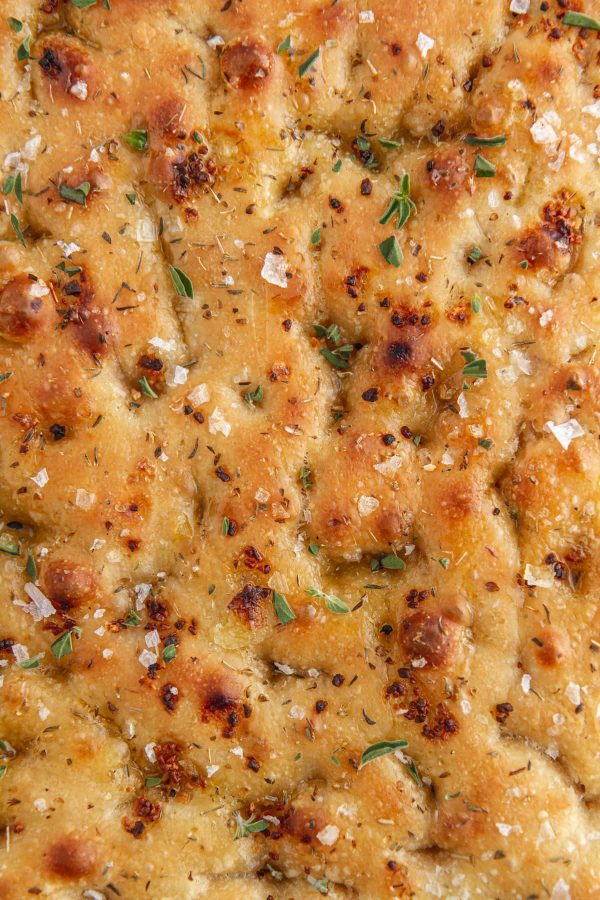
How to Make Easy Sourdough Focaccia
All right! Here’s how to make easy sourdough focaccia bread, from scratch, in the comfort of your own home. Note that this recipe takes several hours to make, so make sure you schedule time to make this bread (trust: it’s worth every minute).
- Step One: Combine your mature sourdough starter with flour, water and salt. Mix everything together, then stir in olive oil. The dough will be very loose; this is normal!
- Step Two: Let the dough rest for several hours. During this time, you’ll perform a few sets of stretches and folds (see below for details on this step). Then, you’ll transfer the dough to a well-oiled 13×9-inch baking pan and gently stretch it into the corners over time.
- Step Three: Once the dough is ready to bake, it’ll be nice and fluffy, with a few bubbles here and there. Dimple the dough with your fingers, then top with more olive oil, some flaky sea salt and any other toppings you fancy (in these photos, I topped mine with minced garlic and oregano). Bake until a deep golden brown.
- Step Four: Allow to cool slightly. Then, dig in.
What you get from the time it takes to indulge in this recipe is a loaf of soft, fluffy, tender, flavorful bread with a delicately crisp crust. Dip slices into olive oil and balsamic vinegar, or use as a sandwich bread with turkey, pesto, tomato and mozzarella (or whatever you have on hand — because really, it tastes good with anything). Repeat on the regular.
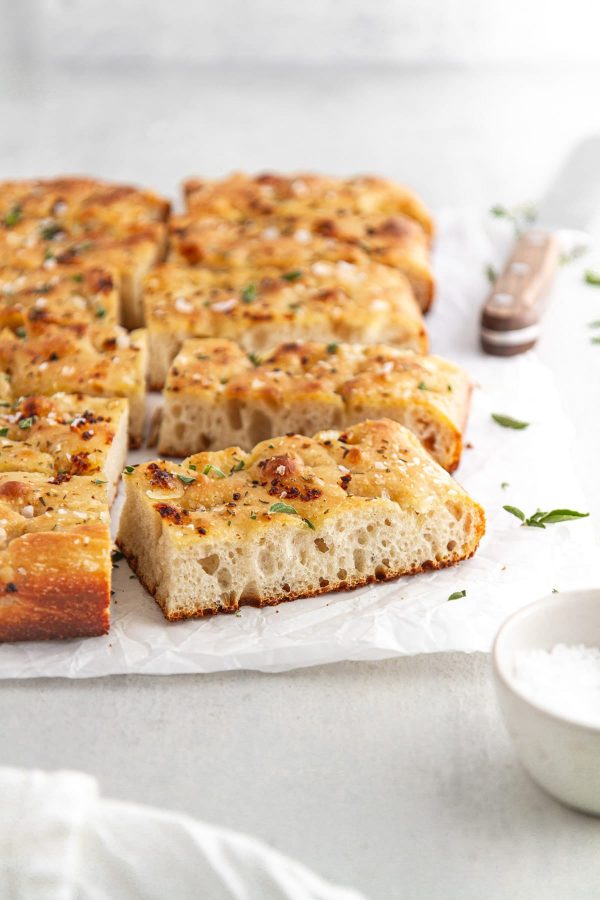
Tips for the Best Sourdough Focaccia of Your Life
As is customary on GVD, let’s discuss a few quick tips before you go off and bake this beauty of a bread:
- You’ll notice that the recipe is written with measurements by weight (as opposed to cups, tablespoons, etc.). This is because, in the case of sourdough recipes, weight is much more accurate and yields the best result. For this recipe, you’ll need to use a kitchen scale to weigh your ingredients.
- The ratio of all-purpose flour to bread flour in this recipe is ideal in terms of the amount of protein in each type of flour to yield the best texture and crumb for focaccia bread. Please use both types of flour as directed if you’re able!
- If you’ve got it on hand, use the best quality olive oil. To be honest, I had a generic brand of extra virgin olive oil from Target, so that’s what I used… and it tasted just fine. But if you’ve got the good stuff, use it for this recipe!
Dear friends: I hope that, no matter how you’re feeling right now, no matter what you’re going through, that baking has been and continues to be a source of comfort (and stress relief). I know for me and my family, we’ll be fully living in carbs for the foreseeable future. And that is something I’m very much OK with right now.
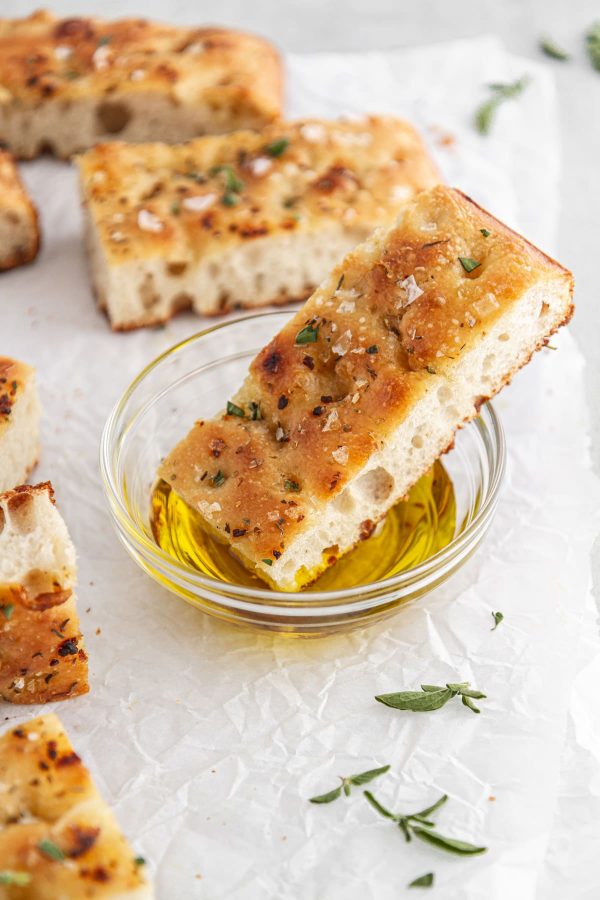
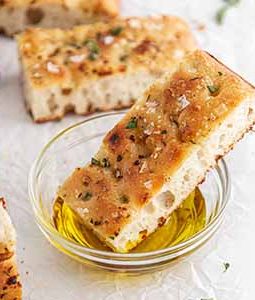
Easy Sourdough Focaccia
- Prep Time: 6 hours 15 minutes
- Cook Time: 30 minutes
- Total Time: 6 hours 45 minutes
- Yield: 12 servings 1x
- Category: Bread
- Method: Bake
- Cuisine: Italian
- Diet: Vegetarian
Description
Use your sourdough starter to make this fantastic sourdough focaccia! With a soft and fluffy interior and a crisp, golden-brown exterior, every bite of this easy-to-make bread is exactly what focaccia should be.
Ingredients
- 345g unbleached all-purpose flour
- 148g bread flour
- 394g room temperature distilled water*, divided
- 9g fine sea salt
- 94g sourdough starter, mature (a.k.a. at peak height)
- 10g extra virgin olive oil, plus more for topping
- Toppings: coarse sea salt, fresh or dried herbs, minced garlic, halved cherry tomatoes, sliced olives, grated Parmesan, etc.
Instructions
- In the morning–around the time you’d usually feed your sourdough starter–add all-purpose flour, bread flour, 344g water (reserve remaining 50g for later), salt and 94g mature sourdough starter to a large bowl. Mix by hand or in the bowl of a stand mixer with the dough hook attachment on low speed just until the mixture forms a dough. Continue to knead the dough by hand, or in a stand mixer on medium speed, until the dough becomes smooth and elastic (about 5 minutes by hand, 3 to 4 minutes in a stand mixer).
- Slowly add remaining 50g water to dough, kneading or mixing on low speed as you go. Continue to knead or mix on medium speed until mixture re-forms into a soft, smooth mass of dough. Drizzle in olive oil, kneading or mixing on low speed as you go. Mix the dough and oil together until everything is fully combined and the dough is smooth and elastic (about 3 to 5 minutes by hand, 1 to 2 minutes in a stand mixer).
- Use a silicone spatula or a silicone dough scraper to scrape dough into a clean large bowl (the dough will be very slack and soft, so don’t try to pick it up/transfer it with your hands). Cover bowl with plastic wrap and let rest in a warm place for 30 minutes (I placed my bowl in the oven, turned off, with the oven light on).
- After 30 minutes have elapsed, uncover bowl. Perform one set of stretch and folds (see the “Bulk Fermentation” section of my sourdough bread recipe for a written explanation + link to a video on what this looks like!), then cover the bowl again and return it to its resting place. Repeat this step (one set of stretch and folds) every 30 minutes over the course of 2 hours. You will end up giving the dough 4 sets of stretches and folds total.
- After the 2 hours have elapsed, transfer the dough gently (so as not to disturb any bubbles that may have formed) to a well-oiled 13×9-inch baking pan (and by “well-oiled,” I mean at least 1-2 tablespoons of olive oil so the dough doesn’t stick to the pan during baking). Cover the pan with plastic wrap and let the dough rest 2 hours, uncovering every 30 minutes to gently stretch the dough with wet hands to the corners of the pan (it will take the entire 2 hours for the dough to relax and stretch, but don’t worry–it will get there!).
- After these 2 hours have elapsed, leave the dough covered and untouched for another 2 hours in its warm place. This is when the dough will puff up and develop more bubbles. About 30 minutes before you plan to bake the bread, place an oven rack in the bottom third of the oven and heat your oven to 450°F (if you have the dough proofing in the oven, TAKE IT OUT before preheating!).
- Before baking, use wet fingers to dimple the top of the dough all over, pressing all the way to the bottom of the pan. Drizzle about 1-2 tablespoons olive oil evenly on top of dough, then sprinkle with desired toppings.
- Bake focaccia until deep golden brown on top, about 30 to 40 minutes, rotating pan halfway through baking. Cool 5 minutes in baking pan, then carefully transfer to a cooling rack. Serve warm or at room temperature.
- Store bread in an airtight container at room temperature up to 3 days.
Notes
- This recipe is adapted from The Perfect Loaf.
- I always prefer to use distilled water in my sourdough bread recipes because there is little chance then of the starter interfering with whatever is in your tap water. However, for this recipe, I didn’t have distilled water, so I just used filtered tap water.
- Questions about sourdough? Head to my Sourdough 101 series for loads of info, including how to make your own sourdough starter, essential sourdough baking tools, my favorite sourdough bread recipe and tips and tricks for sourdough baking.

This looks absolutely gorgeous, especially now that we’re all at home baking bread more often! Love the sourdough addition.
Kelly, Thank you! Pretty sure this focaccia (and all the other breads) is going to be a regular at our house for a while.
Strange situations we are facing. As of yesterday our schools in GA were cancelled for the rest of this term. Hard to believe it has come to this.
BLESSINGS!
Charlotte, So strange! I hope you are staying safe and well at home!
What if I don’t own a kitchen scale…? any chance you can post some measurements?
Nicole, weight measurements for sourdough recipes are preferred to ensure accuracy so you can get the best possible result! This is why I highly recommend a kitchen scale for anyone who is baking sourdough or recipes with sourdough starter. In any case, here are some VERY rudimentary US measurements:
– 2 3/4 cups flour
– 1 cup plus 1-2 tablespoons bread flour
– 1 2/3 cups water
– 2 teaspoons fine sea salt
– scant 1/2 cup sourdough starter
– generous 2 teaspoons olive oil
Thank you GVD. I’ve only recently found your site and find it cute and useful. Plus when I am out of (flour, yeast, butter, etc) the next best thing to baking is watching what other people bake. I have 2 sourdough starters and the one I began oh, around 15 years ago, Tiffany Bubbles, has had a lot of activity lately. (the yeast thing, which, I am thrilled to say, I found a place online and have 3 lbs of yeast heading my way as we speak.)
I am very excited to try this recipe. I will take Tiffany out of the fridge tonight and feed her to get her warmed up to the idea. So far its been lots and lots of sourdough bread, rolls and pancakes. I never thought of focaccia. Thanks!
Tiffany Bubbles; I love it! Thanks so much, Linda!
I just want to let you know that this recipe worked just as well for me with unfed starter straight out of the fridge. It had beautiful airy holes and an almost custardy texture. I used what I was going to discard so I was thrilled that this worked!
Erin, Oh that’s so great to hear, thank you!
Could this proof overnight in the fridge?!trying to time it right for a gathering I have tomorrow.
Courtney, I haven’t tried that and therefore can’t recommend it, but it’s worth a try. Let me know if you do and how it goes!
Going to try tonight. Will let you know.
I just made this today and it’s perfect! I used live sourdough starter that I revived, but will follow your starter recipe next time so it’s truly homemade. Thank you so much for such a great recipe that can be accomplished in a day. I’m in focaccia bliss!
Amazing!
Can I make this with spelt or whole wheat flour?
Cat, I have not tested it with either flour but my guess is there would need to be alterations to the moisture levels. Sorry I can’t be more specific!
Whole wheat or whole grain flours require additional water than white flour, I was told to multiply the amount of water used by 5%, for the whole wheat flour component. To state the obvious, my apologies if too obvious, white flour being used doesnt require an additional 5%.
The recipe has an 80% hydration amount, meaning it will be a wet dough, one suggestion is to hold back the salt until step 2-by doing so you increase the wheats ability to absorb as much water as possible-so let it sit for 5-10 min. Looks like a great recipe. I generally like to use at least half whole meal flour, flour that is untreated by processing, unlike whole wheat for my recipes and of course organic. You go to a lot of trouble making your own bread so might was well use the best ingredients! Good luck all!
loved this bread!
I did not use a scale but it came out amazing anyway,
thank you for this new way of baking for me.
First, most recipes that start with “Easy” usually aren’t. This is no exception. It was a lot of work but not exceptional by sourdough standards. But it was the most difficult dough I’ve every worked with and I’ve made just about sourdough everything. It is so wet. The worst part was that even though I used two full TBS EXVO in the dish, it took almost 3o minutes to get it out. It was so stuck to the dish, was almost impossible. I didn’t just put it all in the sink and soak over night (basically throw it away) because it was so much work. And what I could salvage did taste good, and texture was great. Also, I baked for 30 minutes and should have been closer to 25. Would be worth making if I could get it out of the pan, but won’t be making it again.
Ruth, I am so sorry this recipe didn’t work out for you! Thank you for your feedback.
Is it normal for focaccia to feel greasy…oily fingers when holding? I made this twice. With success, but it’s oily on the outside.
Yes, that’s pretty normal! Focaccia is greasier than, say, a ciabatta bread.
I’m searching for a simple recipe, and yours keeps popping up as if you’ve called it that in your keywords and stuff. BAM! I get hit with a WALL OF TEXT! 9 steps in full in wordy paragraphs. You mistook blog content for recipe steps. You’re supposed to be rambling up in the content and concise down in the steps. That’s what the “jump to recipe” button is supposed to skip.
So sorry to have wasted your time! This recipe is more involved than what you may be used to or expecting, thus the need for thorough recipe steps to ensure success. Anyone who has made the recipe and enjoyed it would probably agree that it’s better to explain the details than to leave them out. I hope you can find a recipe that is simple enough for you, and I’m sorry for what time you did waste coming here and leaving a comment.
For me this was great. Less complex than many I’ve read so far being a sourdough newbie. Thank you.
Now I’m off to read some others of yours to try today.
no fail recipe, I am not a pro, but this does turn out awesome each time for me! Just remember to oil well. My last loaf I used Rosemary, dried tomatoes, garlic and pink Himalayan salt. So good!!